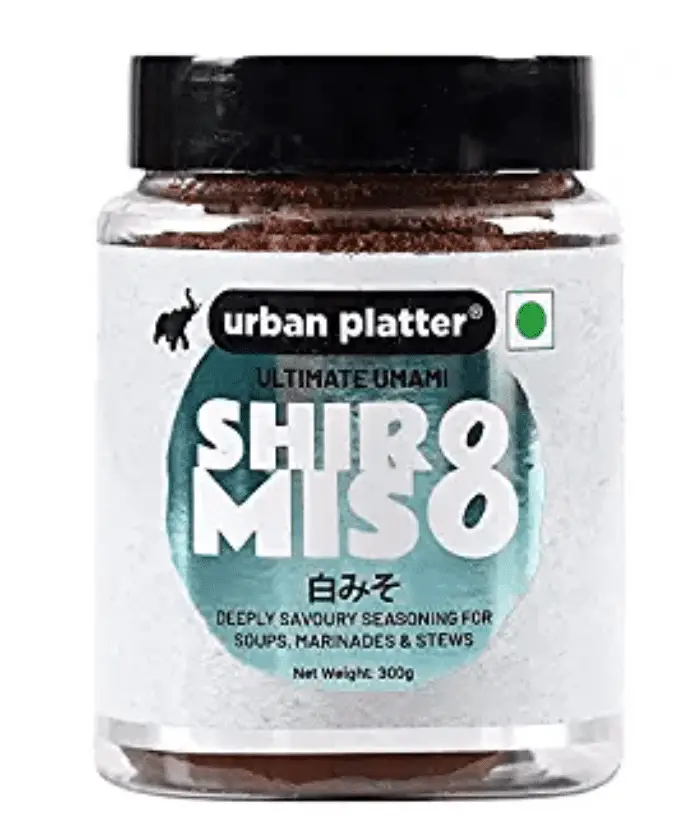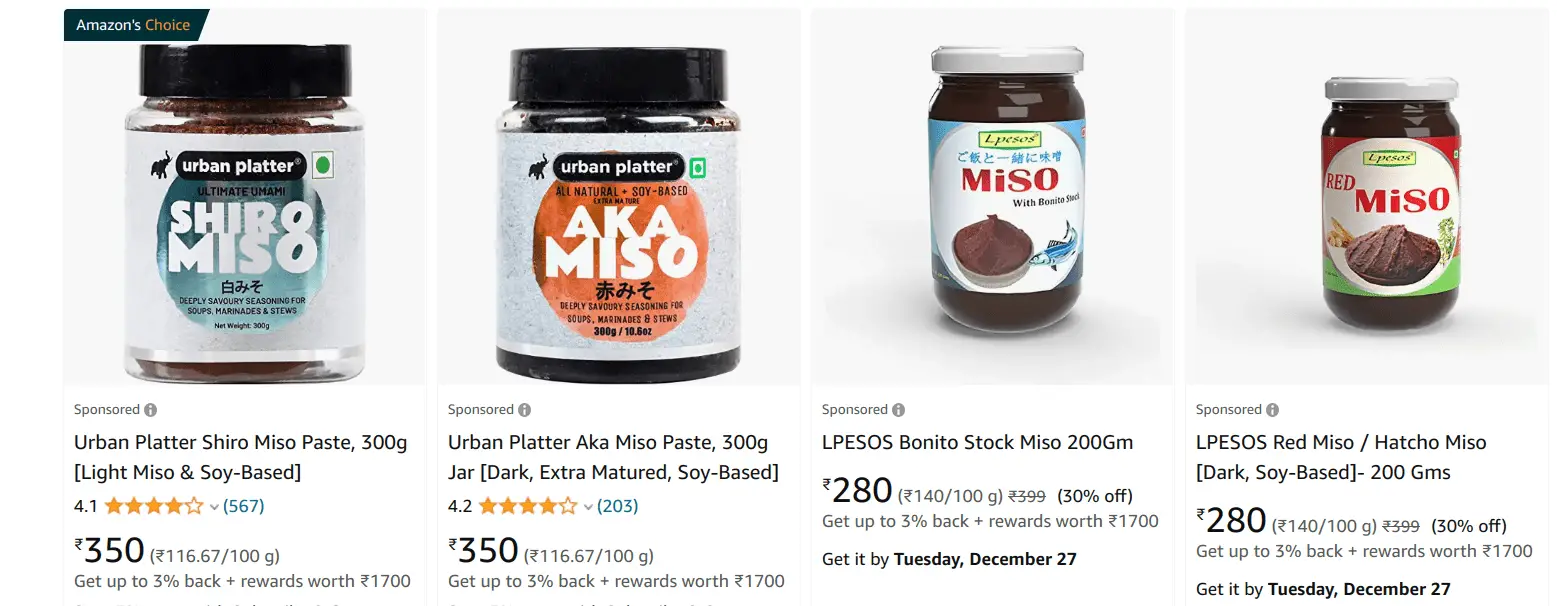Miso paste is made from fermented soybeans and these soybeans are combined with salt and koji, a mold that is used to make sake. The mixture might also include rice, barley, rye and other grains. To get its different flavor, the blend ferments for anywhere from a couple of months to years. The longer it ages, the miso paste gets darker and additional advanced in flavor.
Miso Paste in Grocery Store
Blog Post Content
Simply a tablespoon of this go-to Japanese ingredient will add some serious flavor to tofu or a bowl of ramen. Not only does miso add a savory element to your dish, but it is also good for you. Because it is a fermented seasoning, miso paste contains probiotics and healthy bacteria which may boost your immunity, promote a healthier gut and help alleviate some of the symptoms of anxiety and depression.
How do you cook with Miso Paste?
Miso is a key ingredient in Japanese cooking and forms the base of the staple dish and miso soup. The paste has a similar texture to peanut butter and is typically a culture’s mixture of soybeans.
Miso Paste is splendidly easy to cook with. As an ingredient with a high umami factor, a little miso paste goes a long way to add a savory flavor to your dishes, much in the same way as bacon or mushrooms. There are obvious choices, like slipping a couple of tablespoons of miso into a dressing, like in this ultra-tasty steak with Asian slaw.
The salty paste also makes a killer contribution to meat marinades, especially when combined with other Asian condiments such as rice wine vinegar, soy sauce and sesame seed oil. You can also use miso as a solo flavor. Looking at the range, miso paste may be swish or chunky and is fermented anyplace from some weeks to many years.
Miso paste is ready to use right out of the container and while it is typically eaten alone, it does not need more preparation. The fermented food adds an umami saltiness to anything from desserts to marinades. Miso paste is either dissolved directly into a broth, as seen in miso soup recipes and some kinds of ramen or used as a dip, spread or glaze.
You can mix this Japanese ingredient with mirin and sake to make a marinade for fish the nutty flavors in the miso and the sugars in the marinade caramelize nicely in the broiler. You can also ass a teaspoon of miso paste to your next salad dressing- mix it with a little freshly ground ginger paste, two tablespoons of sesame oil and a tablespoon of rice vinegar. Since miso paste is a fermented food, it will keep in the refrigerator for around a year.
What exactly makes miso important in your pantry?
Because of its miso paste’s savory profile, you can get creative with flavor mixtures. You can not go wrong with miso and ginger with fish. If you have a sweet tooth, a tiny dollop of miso serves as the perfect salty foil for decadent chocolate or caramel dessert. Whether you are a seasoned pro in the kitchen or want to learn a few new tricks, miso paste is an important ingredient to stock in your kitchen cache.
Varieties in Miso Paste
There are more than a thousand types of miso, ranging in texture, flavor and color. All these factors can be influenced by the ingredients, length of fermentation and the conditions under which the miso is kept. Miso paste imported into the United States is typically divided into main categories, light or white miso and dark or red miso.
Some miso paste is labeled awase, which is a combination of more than one kind of miso paste. White of light miso (sometimes called sweet miso) can be might beige to yellow in color and tends to be lighter and sweeter in flavor thanks to a shorter fermentation time. It is made with less soybean content and more grains such as white rice. Red or dark miso changes in color from light brown to almost black and is fermented for longer for a stronger, funkier and saltier flavor.
This miso paste is made with a higher proportion of soybeans and salt for an intense experience. Various types of miso paste can often be used interchangeably in recipes but with different results. Generally, the darker the color, the stronger the taste of the miso paste. Light-colored miso is better for light dressings and sweets, while dark miso is best for long stews and braises.
While the miso paste selection is somewhat limited in the United States, a dizzying variety is available in Japan, with various regions specializing in various types of miso paste. Varieties like Hatcho (dark miso) and genmai (made with brown rice) can sometimes be found stateside.
Uses of Miso Paste
Miso is a paste that can be mixed with dressing, soups, sauces and batters. It can be eaten raw or cooked. Since miso paste is cultured food and it is best to add it to long-cooked dishes at the end of cooking. You must be careful not to boil dishes such as miso soup- too much heat will kill the active bacteria in the miso paste.
What does Miso Paste like?
It is got a texture that is a little like peanut butter. It is ready to use straight out of the pack and does not need any special preparation but it is not really meant to be eaten on its own. As for that much-loved miso paste flavor, it is salty, savory, a little bit meaty and sometimes can be a little funky too in a good way. Miso paste adds heaps of depth to a variety of dishes but uses it sparingly, You can always add something more.
How to store Miso Paste?
Miso paste contains a long shelf life, if you follow the storage directions, of course. You must tend to keep it in the fridge and can also press a small piece of baking or parchment paper onto the top of the miso paste to give it another layer to protect it from oxidation. You must also us clean utensils when you scoop a bit of miso paste out of the pot so that you do not contaminate it.
Where to buy Miso Paste?
When shopping for miso, you may find it called soybean paste or miso paste. You should look for miso in jars or plastic tubs in the Asian grocery store or the refrigerator section of your local health food store.
Some giant grocery stores stock miso in plastic tubs closes to the refrigerated tofu. You should look for miso paste that is with a short ingredient list, free of stabilizers and preservatives.
You can choose e variety of light or dark, etc that will work best in your planned recipes. Miso paste is widely available in supermarkets, you would typically find it near other Japanese ingredients in most grocery stores, If not, you will definitely find it at your nearest Asian grocer or online.
Common types of Miso Paste
In the United States, varieties of miso paste are typically categorized by color, while in Japan they are more often categorized by flavor and ingredients. The different types of miso paste all have different fermentation, times, seasonings and ingredients-
White Miso Paste
White Miso Paste is also known as shiro miso, white miso paste originated from Kyoto and is the most commonly produced type of miso. White Miso Paste is made with barley, rice and soybeans, shiro miso paste has a mild sweet taste.
Red Miso Paste
Red Miso Paste is also known as aka miso paste, red miso paste has a longer fermentation time than white miso paste, which gives it a deeper color. As the color shifts to a rusty red, typically even black, the saltiness deepens and also the flavors increase in intensity.
Yellow Miso Paste
Yellow Miso Paste is also known as shinshu miso paste, yellow miso paste contains less salt than red miso paste and has a more acidic taste. Yellow Miso Paste ranges from light yellow to light brown.
Awase Miso Paste
Awase Miso Paste is also known as mixed miso paste, awase miso paste is a mixture of white and red miso pastes. Awase miso paste is one of the most versatile varieties of miso paste since it mixes the mild sweetness of white miso with the richness of red miso paste.
Kome Miso Paste
Kome Miso Paste is one of the most widely available and it can be found in various colors such as yellow, red and white. Types of Kome miso paste vary in sweetened and strength, with nuanced as specific as whether the soybeans in the paste have been steamed or boiled. Most miso pastes in United States grocery stores are kome miso. In Japan, kome miso paste is especially prevalent in the Kinki region, Hokuriku regions and the eastern part of the country.
Mugi Miso Paste
Mugi Miso Paste is also known as barley miso, mugi miso paste is made from barley malt and soybeans. in Japan, mugi miso paste produced in Kyushu is a white variety while mugi miso paste produced in the Kanto region is a reddish brown or dark brown color. Mugi Miso Paste tastes sweet and has distinct malty funk.
Mame Miso Paste
Mame Miso Paste is pure soybean miso paste that is reddish brown and made without any grains. It has a rich, pungent flavor and will be aged up to a few years. One of Japan’s most famous miso is hatcho miso paste, a variety of name miso paste that is particularly in the city of Okazaki.
Genami Miso Paste
Genami Miso Paste is also known as brown rice miso paste, genami miso paste is a red miso paste variety with a distinct nutty flavor.
Why eat Miso Paste?
Miso paste is a traditional Asian ingredient. These days, it is appreciated for its taste as well s its health benefits. Miso paste is famous for the popular miso soup but it can be used anywhere you use soy sauce or salt.

